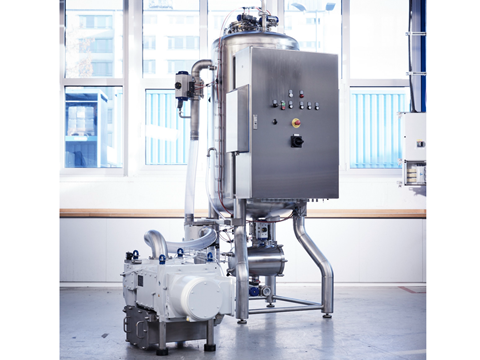
Leybold GmbH has introduced its Beer Bottling Vacuum System (BBVS) to replace liquid ring pump technology for beer bottling, said to require 15-20% less energy and reduce cooling water requirements by 80%.
Leybold says the BBVS is designed as an ‘all-in-one turnkey solution’ to replace the old liquid ring pump technology. It includes a separator tank with an automatic operated draining vessel to stop foam and liquid carried over from the filler via the gas flow.
Apparently, the DRYVAC dry screw vacuum pump provides constant vacuum levels and an electrical cabinet with Programmable Logic Controller (PLC) controls the system. The equipment can be interfaced with the filler via digital Input/Outputs (I/Os) or a fieldbus for remote control, and can also operate as a stand-alone system via push buttons.
The DRYVAC’s screw design apparently requires 15-20% less energy than a liquid ring pump to deliver the same flow at the same working pressure, and Leybold says cooling water requirements are reduced by 80% compared to liquid ring pumps when using fresh water. The DRYVAC also has a separate cooling circuit which makes it possible to reuse water for tasks including bottle exit showers or lubricating conveyor belts.
The company adds that the DRYVAC pumps and BBVS system improve bottling vacuum levels, said to positively impact the Total Packaged Oxygen (TPO), which affects taste and shelf life. BBVS product manager Sven Hanses says a CO2 reduction is possible. “Since the bottles are flushed with CO2, improved vacuum also leads to a reduction in CO2 consumption, as some of the oxygen is already removed via the evacuation process,” he says.
Leybold’s two water-cooled DRYVAC models, the DV 650 FP-r and DV 800 FP-r, have a screw vacuum pump designed for harsh industrial processes. The models are said to have quiet operation, with the DV 650 FP-r generating a noise level of 67 dB(A) and the DV 800 FP-r generating 70 dB(A).
The company says this allows the pumps to be installed in the immediate vicinity of the filling systems, and the DRYVAC models generate and emit little heat. The ‘comparatively low’ internal temperature profile of the screw vacuum pump is said to prevent caramel layers forming that can potentially appear when sugars, carried over with residual beer droplets, are exposed to high temperatures.
Leybold states that a Cleaning in Place (CIP) spray ball in the top of the stainless-steel separator means all surfaces that come into contact with beer can be cleaned, and this can be done without dismantling or switching off the system.
In related news, Carrefour Belgium, Cornet Beer and DW Reusables developed a returnable six-pack for beer in April, following the new reusable packaging regulations set out in the European Packaging and Packaging Waste Regulations (PPWR). The packs reportedly reduce the risk of pre-opened, unsellable units or damaged goods, with the crates cleaned after each use at socio-economic company MIVAS.
Smurfit Westrock announced earlier this month that it has produced ‘shelf-ready’ beer boxes for Woodforde’s, designed to resist water damage, stand out on supermarket shelves and attract repeated purchases. The design hopes to decrease the likelihood of products being damaged and wasted by increasing the pack’s durability, and in doing so save costs and increase customer satisfaction.
If you liked this story, you might also enjoy:
How are the top brands progressing on packaging sustainability?
Sustainable Innovation Report 2024: Current trends and future priorities
Reuse vs. single use – which is better for the environment?
The ultimate guide to global plastic sustainability regulation











No comments yet